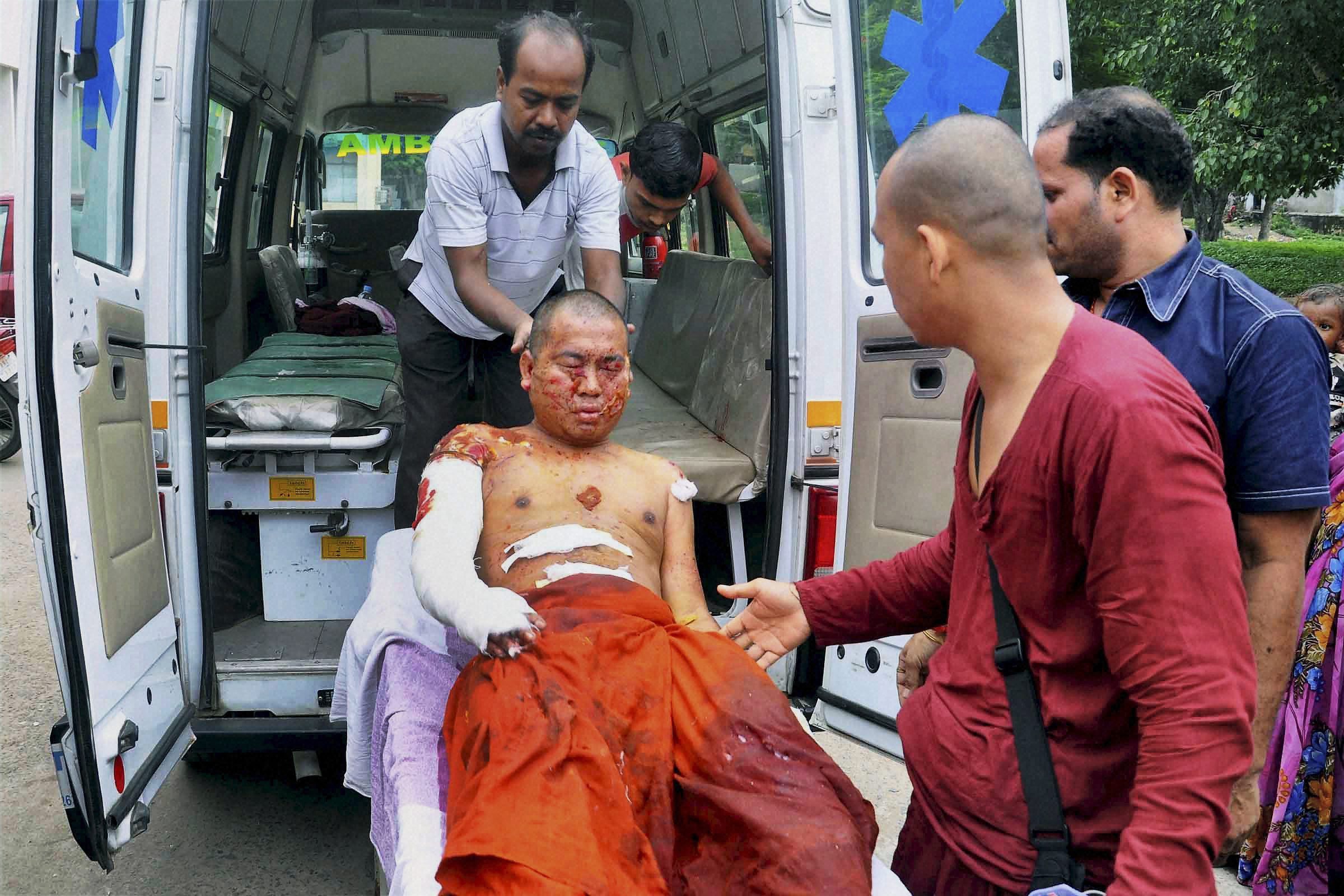[cycloneslider id=”moist_story”]
The road undulates through a jungle near the picturesque Netarhat town in Latehar district of Jharkhand. The only vehicular traffic for several kilometres is an occasional motorcycle. The still winter afternoon is broken by the determined trudging of jungle boots, a standard issue for the Central Reserve Police Force (CRPF) personnel. They stop their patrol and peer suspiciously into our vehicle after flagging it down.
The jawans grip their automatic rifles to their chest for comfort, unaware that the weapons have become an extension of their body. They are ready to scuttle the faceless enemy that roams these jungles — armed militia of the banned, left-wing extremist CPI (Maoist). As if making casual conversation, Assistant Commandant Biswas asks for our identification, destination and purpose of entry into the forest. Civilian entry means journalists or human rights activists, and in the eyes of the security forces, both of these categories often overlap with Maoist couriers, conduits and sympathisers.
Satisfied with our response, Biswas waves us ahead after a brief chat. Some of his younger colleagues still seem a little apprehensive. They carry Tavors, an Israeli-made sub-machine gun, the standard issue for CRPF’s elite forces, Combat Battalion for Resolute Action or COBRA. The only reticence is from two district police officers in each company, easily recognisable from their shabbier boots and bulging paunches, carrying guns that look like they were last oiled during the 1962 Sino-Indian war.
There are several such patrols along the way. They are not special; they are ‘area dominance’ patrols to ensure that the Maoists don’t stray back into their old territory.
But, that’s until 3 pm, which is when the patrol teams recede into their permanent camps. In a few hours, the Maoists will take over charge of the forests with the setting sun under the leadership of Deo Kumar Singh, known by his ‘revolutionary’ name Arvindji. Somewhere in his 50s, this native of Jehanabad in Bihar has risen up the ranks to be a member of the central committee of the CPI (Maoist). Soon, he is slated to become a member of the Maoists’ top decision-making body, the politburo. Arvindji has recruited and trained Maoist cadres and led and strategised operations that have caused maximum damage in the past few years. He is also the in-charge of Bihar-Jharkhand for the Maoists’ central military commission.
Depending on the mission, he moves with teams ranging from five armed members up to 400. Until a few years ago, he travelled only on horseback. Hi-tech surveillance via drones and satellites have put a stop to that.
According to Maoist leaders, Deo Kumar Singh started off as a restaurateur at Dehri in Bihar in the 1980s. This was before the merger of Maoist Communist Centre (MCC) with factions of the CPI (Marxist-Leninist) to become the CPI (Maoist) in 2004. During the 1990s, Narayan Sanyal, leader of one of the factions, called CPI (ML)-Party Unity, recruited and trained Singh. Sanyal, who later became a politburo member of the CPI (Maoist), is lodged at Hazaribagh jail in Jharkhand.
Arvindji rose up the ranks and built a reputation as a guerrilla soldier through two decades of attacks, encounters and arms snatching. Until his arrest in 2006, Keshwar Yadav aka Ranjanji was heading the Bihar-Jharkhand-North Chhattisgarh Special Area Committee (BJNCSAC). Later, the Maoists labelled Yadav as a traitor for allegedly cutting a deal with the police and betraying his comrades. After his acquittal, Yadav is now a businessman in the same place he once terrorised and has fought elections on CPI (ML) Liberation and Rashtriya Janata Dal tickets. After Yadav, Ravi Sharma (Arjunji) took over as member-secretary of the BJNCSAC. Sharma, who the police claim is a central committee member, was an agricultural scientist from Andhra Pradesh and was arrested by the Andhra Pradesh Police’s Greyhound unit from Patna in 2009.
In 2011, Arvindji was made the military chief of BJNSAC with the endorsement of slain Maoist leader Kishenji, who was the then military in-charge for the entire Eastern Bureau region.
In January 2013, security forces unwittingly stumbled upon Arvindji’s new military strategy devised by the Maoists’ central military commission chief Nambala Keshava Rao. Arvindji is a member of the commission.
His guerrilla battalion, which had 350-400 armed militia, was conducting a drill on decentralisation of an advancing army, which breaks into smaller fighting formations to attack as it advances in the jungle and then regroups at a pre-mapped location. This is the Maoists’ idea for their ‘long march’ formation and it is under this leader that the Maoists are now performing drills of travelling in army formations as opposed to moving in the traditional smaller guerrilla formations such as squads and companies of up to 100 guerrillas.
With intelligence inputs on a large ‘movement’ in Katiya forest in Latehar district, the security forces rushed in and suffered heavy losses. The Maoists cut open the bellies of three slain jawans and planted timed bombs in them. Two detonated while they were being recovered, killing villagers. One was detonated at a government hospital in Ranchi. The Maoists even stripped the uniforms of the jawans and waited on treetops wearing these. One CRPF officer was killed when he failed to realise that the person perched on a tree was a Maoist.
These strategies were devised and undertaken by Arvindji and his lieutenants such as Lalesh Yadav, who was killed in March last year by a vigilante group called the Tritiya Sammelan Prastuti Committee (TSPC). In an interview with this reporter, six months before his death, Yadav had spoken about how Arvindji plays it by the book and trains equally in ideology and weapons and explosives. Yadav, his protégé and the then secretary of the Maoists’ Bihar state committee, could spout Maoist ideology with the same ease as he could fire a gun.
The Katiya encounter exposed that despite specialised training, the security forces were unable to keep up with the Maoists who were also changing their strategies.
“We act on information whenever we receive it and have not let up in pursuing Maoist leader Arvindji,” says Jharkhand Jaguar (STF) IG MS Bhatia. “We have tried several times to encircle him and his cadres but such a tactic is only possible in urban areas. There are several difficulties arising out of the hilly terrain in Jharkhand, which they use to their advantage to escape.”
For the Union home ministry, Arvindji is enemy No 1 in Jharkhand. Organisationally, he is junior only to politburo members Mihir Besra and Prashant Bose. His area of operations roughly includes Palamu, South Chhotanagpur (Simdega, Gumla, Ranchi, parts of Khunti districts), Garhwa, Chatra and Latehar districts in Jharkhand and Aurangabad and Gaya districts in Bihar.
The Maoists’ arms and explosives pipeline relies heavily on these routes and that’s why Arvindji plays an important role. He also uses the classic technique of attacking security personnel and seizing their weapons.
Arvindji is a career rebel but his family dabbles in business, which he despises. His wife, Prabhavati Devi, is an exception and is an anganwadi sevika in Jehanabad. In 2012, she was arrested in Patna and the police claimed to have caught her with Rs 27 lakh, which the Maoists claimed was planted on her. Media reports speculated that Arvindji was siphoning off levy money.
Reportedly, one of Arvindji’s sons, an IIT graduate, is an entrepreneur, while another son runs a coaching institute in Patna. One of his brothers-in-law runs a cab service, while another is a realtor.
In March 2013, another intelligence input led to a 24-hour-long encounter between 150 Maoists and nearly a full battalion (less than 1,000) of the security forces. The Maoists were receiving explosives training in the semi-‘liberated’ zone near Sibil-Luru mountain in Gumla district of Jharkhand. After the exchange of gunfire, Maoist sub-zonal commander of this area, Nakul Yadav, managed to get Arvindji out safely, after killing one security personnel.
Later that month, the TSPC took out Lalesh Yadav, which the Maoists claim was a CRPF-supported move. The security forces find it tough to move around in the forests, but the vigilante groups operate in the same way as the Maoist guerillas. There were several smaller encounters during the rest of 2013 whenever there were ‘intelligence inputs’, but Arvindji managed to be a step ahead of the probing satellites and the security forces these satellites or local informants sent his way.
In July 2013, a Maoist drill was in progress in Kumandi of Latehar district, Jharkhand, when security forces surrounded the area. Arvindji, who was unwell at the time, managed to escape yet again as did his entire army. The police claimed to have killed many Maoists but no bodies were recovered. Once again, the hilly terrain helped them as company after company retreated while some remained to give them cover.
This happened over a period of nearly three weeks during which Jharkhand DGP Rajeev Kumar visited the spot. Little known to the security forces, while the police were still searching for him in Kumandi, Arvindji had already made it 200 km south to Simdega district to meet with his superiors.
A senior home ministry official said that the Jharkhand Police and Central security forces are targeting Arvindji, hoping to subdue the guerrilla activity in the same way as West Bengal did. “Arvindji wants to gain control of Palamu zone of Jharkhand because it is strategically important to them and historically it was one of their first liberated zone-cum-headquarters in the area,” he said. “Vigilante groups such as the TSPC take on his troops but they are unable to make a dent. But they are gaining ground. When they cannot fight in the jungles, he regularly travels to Gaya and Aurangabad in Bihar.”
Even government officials admit that Arvindji is not just a gun-toting, blood-crazed guerrilla but strong on ideology and lives by it. Besides, the Kurmi leader treats his soldiers well but punishes offences such as freeloading from villagers, which makes him popular among the villagers. But he steers clear of making statements to the press and giving interviews, knowing his audience is different and prefers addressing people directly.
The veil of mystery and military prowess means prompt levy payments from businessmen and corporate entities that operate in this mineral-rich zone. Now, Arvindji has become the greatest thorn in the flesh of the State in eastern India since Kishenji, minus the flamboyance.





Maoist groups should be fighting the invaders in Bangladesh. They have taken from land from India; this Maoist must realize. Don’t blame the government for not meeting all the needs of the people, the government is under pressure too, and even bigger than you can imagine. I would advise Maoist to attack Bangladesh in full force if it is land you want. I can’t say go Pakistan as it is very far away, Bangladesh is closer. This in turn will benefit the country more so the ones that fight for it, rather than make things worst. The land the Maoist wants is in the hands of invaders. Maoist do have a good force, that needs to focus on the real issues like Bangladesh and Pakistan is filled with Muslim invaders. I
Maoist groups should be fighting the invaders in Bangladesh. They have taken from land from India; this Maoist must realize. Don’t blame the government for not meeting all the needs of the people, the government is under pressure too, and even bigger than you can imagine. I would advise Maoist to attack Bangladesh in full force if it is land you want. I can’t say go Pakistan as it is very far away, Bangladesh is closer. This in turn will benefit the country more so the ones that fight for it, rather than make things worse. The land the Maoist wants is in the hands of invaders. Maoist does have a good force, which needs to focus on the real issues like Bangladesh and Pakistan is filled with Muslim invaders.